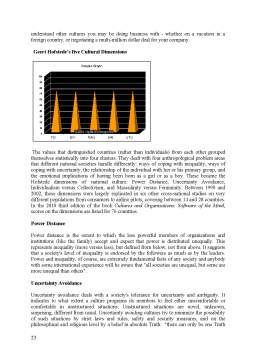Extras din curs
I. INTERCULTURAL COMMUNICATION. FRAMEWORK
Cultural diversity and multiculturalism are the realities of everyday life for almost everyone. The growth of interdependence of people and cultures in the global society of the twenty-first century has forced us to pay more attention to intercultural issues. In order to live and function in this multicultural environment as effectively and meaningfully as possible, people must be competent in intercultural communication. Therefore, demands for intercultural communication skills are increasing as more and more businesses go global or international. Without the help of intercultural communication we can unknowingly cause confusion and misunderstandings. For these intercultural businesses to breach the cultural barriers encountered when stepping into foreign grounds it is vital for business people to fully understand the cultural differences that exist so as to prevent damaging business relations due to intercultural communication gaps.
All com is culture.Working, meeting, dealing, entertaining, negotiating and corresponding with colleagues or clients from different cultures can not be perceived outside the frame of intercultural communication. This field is of importance to international businesses as it examines how people from different cultures, beliefs and religions come together to work and communicate with each other. However, the basic skills of intercultural communication are fundamentally general communication skills that can be used universally by all cultures and races. An example of such communication skills in the intercultural environment is to listen without judging, repeat what you understand, confirm meanings, give suggestions and acknowledge a mutual understanding.
• Intercultural communication is a form of global communication. It is used to describe the wide range of communication problems that naturally appear within an organization made up of individuals from different religious, social, ethnic, and educational backgrounds.
• Intercultural communication is sometimes used synonymously with cross-cultural communication. In this sense it seeks to understand how people from different countries and cultures act, communicate and perceive the world around them.
Being aware of intercultural issues, understanding and appreciating intercultural differences ultimately promotes clearer communication, breaks down barriers, builds trust, strengthens relationships, opens horizons and yields tangible results in terms of business success. Hall introduced terms such as “intercultural tensions” and “intercultural problems” in 1950 and “intercultural communication” in 1959.
A Short History of Intercultural Communication
Although the phenomenon of intercultural communication is as old as human society, the study of intercultural communication is of recent origin.
It was first started in the United States. Communication scholars commonly rec¬ognize E. T. Hall as the father of the field of intercultural communication study . He conceptualized this new field of ICC in the early 1950s when he worked for the U.S. Foreign Service Institute . He popularized this new area of communication in his book, The Silent Language, published in 1959, which is considered the founder of intercultural communication study and a classic in this field.
Hall introduced terms such as “intercultural tensions” and “intercultural problems” in 1950 and “intercultural communication” in 1959.
The field of ICC has continued to prosper in the United States considering the following reasons:
- The United States provide many opportunities for people from different cultural backgrounds to communicate with each;
- There are thousands of new immigrants entering the country every year;
- The U.S. has large numbers of foreign students and tourists; and
- The American involvement in the global economy: the majority of America’s Fortune 500 Corporations are multinational and transnational companies with numerous employees and offices in many different countries in the world.
There had also been an anthropological tradition in the study of race and culture in U.S. that contributed to the further development of ICC. Anthropologists contributed to the later development of ICC through their studies and research of race and culture. For example, Ruth Benedict is the anthropologist who coined the term “culture shock,” which is defined as the traumatic experience that someone may encounter when entering a different cultural environment. Benjamin Lee Whorf, a student and colleague of Sapir’s at Yale University, advanced the theory that language influences perceptions and thus human behavior.
The major points in the development of ICC are:
• Culture and communication were studied separately until recent years, and it was not until the early seventies that scholars started to relate culture to communication.
• In 1970, intercultural communication was recognized by the Intercultural communication Association (ICA), and since that time, many changes in the discipline have taken place, such as ICC being offered as a course of study at many American universities.
• In the early 1970s, serious training in the field of intercultural communication was begun. The first training actually started with Peace Corps members, who were being prepared in ICC before being sent abroad in the 1960s and 1970s, to countries in the Asian and African continents.
• Sietar (Society for intercultural education, training and research) was set up in 1975; and it is probably the largest international organization engaged in intercultural communication.
• In 1977, an academic journal entitled International Journal of Intercultural Relations was first published.
• The International Association of Communication has a membership of over five thousand members.
As Hart (1996) summarized, this new field of study originated in the United States in the late 1950s when anthropologists made studies of the native Indians and the problems U.S. diplomats at the Foreign Institute Service had with people from other cultures. The study of intercultural communication gained acceptance through training and testing practice in the 1960s and 1970s, formed its basic framework in the late 1970s and has made great achievements in theory and practice ever since the 1980s both inside and outside the U.S. Today intercultural communication not only has become one of the major academic disciplines in the United States but also is widely acknowledged and extensively researched in all parts of the world.
Preview document
Conținut arhivă zip
- Intercultural Communication.doc






























































